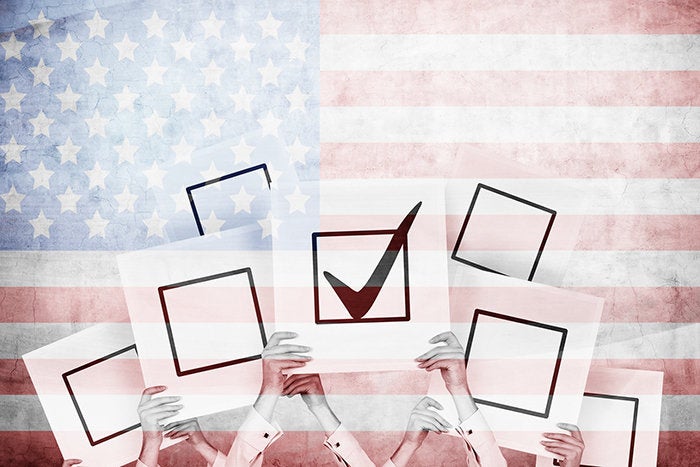Which Internal Reports Present Information With Little Or No Filtering Or Restrictions Of The Data?
Political data reporting malpractice
Focusing on national political stance instead of the Electoral College breakdown may make this yr'due south Presidential race expect more than exciting, but information technology's terrible data analysis

"Trump Leads Clinton by 1 Betoken in New Poll as Enthusiasm Declines" blares the headline on an ABC News story about next week's presidential ballot. That may well exist true. Just it is likewise information malpractice.
Why? Two reasons.
ane) They are deliberately measuring - and emphasizing - something irrelevant. Buried after 10 paragraphs of text and 2 large graphics: "In blue states (with 278 electoral votes), Clinton leads 54-37 percentage." Um, ane candidate has a large lead in states with 278 balloter votes, and only 270 are needed to win.
Nowhere in this ABC Web story did information technology even mention that Hillary Clinton is comfortably alee in states with enough electoral votes to win the ballot. National political opinion may or may non be shut. It might indeed exist interesting to expect at national opinion versus how the Balloter Higher is shaping up. Simply the popular vote doesn't matter when it comes to who wins (just ask non-former-President Al Gore).
This is just the most egregious example of "the presidential race is tightening!" media coverage of national political-opinion numbers that misleads people into thinking the contest is closer than it is. It'southward a bias of some - but not all - reporters, editors and producers who want the election to exist a nailbiter considering a close race is a lot more interesting than i that looks to be by and large decided. Who wants to say "this subject I've been writing about endlessly for ii years actually isn't exciting anymore?" Admitting that the odds of i candidate winning the ballot are pretty substantial risks a pass up viewers and Spider web clicks (not to mention charges of partisanship from the candidate who's behind).
Just measuring popular vote instead of state-by-country electoral college polls is sort of like of following the World Serial by tracking how many runs each team scores overall. What matters is number of games won. You tin also talk about batting averages and ERAs and, yes, runs scored. Only the main news is who wins. In a playoff series, one team's v-2 win does not outweigh some other team'due south two victories of 2-1 and one-0.
2) Poll results -- even ones with excellent methodology -- are likely to bounce effectually. That's partly considering of polling margin of mistake but also confidence intervals. Usually, polls report margins of error at 95% conviction intervals (or sometimes 90%) -- but the confidence interval is rarely included in news reports. What a 95% conviction interval means, though, is that even with correct methodology, 1 time out of 20, the bodily value of candidates' back up is going to be outside the poll's margin of error. (And this doesn't fifty-fifty account for the added complexity of trying to model which people will actually turn out and vote as opposed to those who have opinions but stay abode.)
Every bit Sam Wang at the Princeton Election Consortium explained in his post, Why did the polls seem and so variable this week: "The bones answer is that there were a lot of them. Outliers are an inevitable consequence. . . . this amount of variation is totally natural. Information technology's kind of similar watching dogs in the park. If you wait for x of them, you're more than likely to see a big or small 1. But what we desire here is the median dog. The more polls there are, the wider the range of outcomes that you'll encounter." (accent mine). A calendar week before the ballot, there are likely going to exist lots of polls released.
Experts who are serious almost trying to make sense of political polls advise that information technology's best to wait at poll aggregates. That'due south how you don't give outliers too much weight. Nate Cohn at the New York Times, whose coverage of political data has been outstanding, had some excellent advice.
"You've probably heard that it's ever best to focus on the average of polls. The poll results that often go the most attention are outliers — they go attention considering they're shocking, not because they're representative," he wrote in his The Savvy Person'a Guide to Reading the Latest Polls. "Only nosotros likewise know that people ofttimes ignore that advice. They desire to know the details of the newest poll, and how and why it might exist dissimilar from the last. And to tell yous the truth, I practice, likewise. I read the details and methodology of almost every survey that is released."
If that's you lot and you want an informed way to look at the latest poll numbers and not just aggregates, read his Guide. Just too remember that if the poll is just measuring national opinion and not Electoral College breakdowns, the results don't mean much -- no thing how authentic they are.
Copyright © 2016 IDG Communications, Inc.
Which Internal Reports Present Information With Little Or No Filtering Or Restrictions Of The Data?,
Source: https://blogs.computerworld.com/article/3137484/political-data-reporting-malpractice.html
Posted by: tathamferamplon.blogspot.com


0 Response to "Which Internal Reports Present Information With Little Or No Filtering Or Restrictions Of The Data?"
Post a Comment